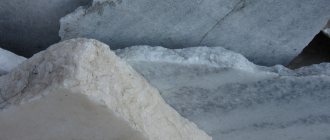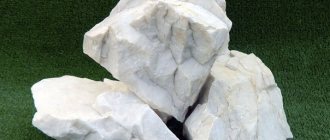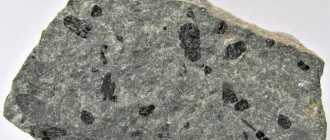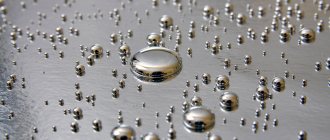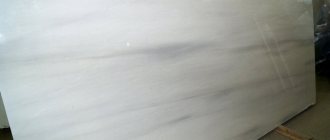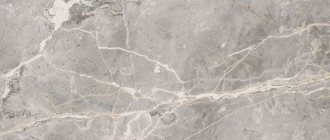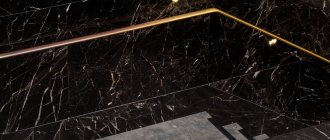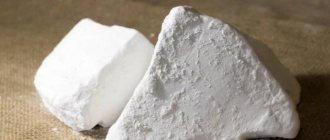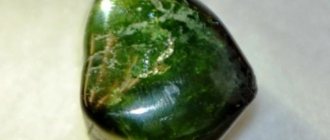Marble is one of the most popular stones, which is most often used in decoration and making souvenirs, amulets, and interior items. Its name can be translated from Latin as “stone that glitters.” Marble is formed from dolomite and limestone rocks under the influence of high pressure and temperature fluctuations, and its varieties and colors directly depend on what substances are included in its composition. The unique crystalline structure of natural material creates wonderful and unique designs. One of the most beautiful types of this stone is green marble.
History of origin and characteristics
Green marble is the material from which products are made that have come to us from ancient times. Stone is very durable in its structure, which is why history has preserved for us unique masterpieces of ancient masters in the form of vases, bathroom decorations for the Roman nobility, furniture and sculptures. All the green shades of this marble are due to the fact that it was formed in an environment with a high content of iron and its compounds.
This amazing stone often delights people with its bizarre colors: for example, red, gray, yellowish and black splashes on a general green background. The typical color is greenish mixed with other shades: for example, pale green with white stripes, which looks unusually soft and airy. It can also be a thick dark green color of calm shades, which is the personification of prosperity, harmony and peace.
Like other natural materials used in everyday life, green marble has its own advantages and application features that should be taken into account when using and processing it:
- it is unusually plastic - easy to process;
- has good strength, does not crumble, does not crumble during processing, and withstands mechanical stress;
- thanks to its strength, you can create wonderful patterns, any figures and bas-reliefs from it;
- durable (especially dark types of marble) and able to live a long life, for many centuries, without changing either structure or color;
- resistant to low temperatures due to the natural feature of a low level of moisture absorption;
- also resistant to chemicals;
- environmentally friendly and absolutely safe - it is not a conductor of current or an accumulator of harmful substances;
- suitable for finishing rooms with high humidity;
- has an antibacterial effect, does not accumulate microorganisms - the air will always be fresh and clean, especially in the bathroom or sauna.
With all this, it is worth noting some “cons” of this stone. For example, its use in high-traffic areas is not recommended: large amounts of dust, dirt and solid particles will quickly lead to external wear of the stone surface. Also, despite its resistance to chemical compounds, marble is very afraid of acid, even food acid, and under its influence can be subject to gradual destruction. Due to the heterogeneity of its colors, it can be problematic to treat a room with a large area.
Description
Marble is translated from ancient Greek as “shining stone”. This rock is formed in the thickness of the earth's crust from limestone under the influence of certain physical and chemical conditions. It consists of calcite (calcium carbonate) with an admixture of other minerals, which affect its quality and color to varying degrees. Green marble is formed over a long time and receives its shade only when it contains iron silicates (if there were deposits of tremolite and serpentine nearby). It has a branched pattern, wavy patterns due to veins of brown and white shades.
Scope of application of green marble
Green stone of different shades has long been used in the construction of palaces of noble persons and the creation of interior items. Green marble is discreet and modest, but its color, especially the rich dark tones, amazes with its splendor, especially in the form of flooring, wall decoration and wide grand staircases.
With the help of marble, a variety of types of cladding are still made: fireplaces, massive furniture and other products that can become not only a “museum rarity”, but also successfully used in everyday life. This stone is distinguished by its flexibility in processing and fairly high strength, so any product made from it, with proper care, can be used for a very long time.
In the building materials market, green marble has a special status due to its rarity. It is in great demand and has corresponding prices that are worth it: the strength of the material, combined with its diversity and the unique beauty of the transitions from one color shade to another, have no analogues.
Marble cladding of varying degrees of complexity is still popular to this day: any green color will create coziness in the office, despite the fact that the stone, at first glance, may seem cold and too heavy. Thick dark green tones will harmonize perfectly with natural wood furniture in dark shades.
In the bathroom, green marble looks surprisingly cozy and fresh - especially if you think through the lighting and lighting plan in detail. It can also be used to make small souvenirs that are used in offices: watches, figurines of various animals, decorative inkwells with feathers. Green stone looks very solid and presentable when decorating bar counters, billiard tables and reception areas in large hotels.
The green color in itself is capable of creating an atmosphere of life and productive activity, and in combination with a natural stone of natural origin, these properties are enhanced several times, having a beneficial effect on a person’s spiritual sphere.
By color
Marble can contain various kinds of impurities in one quantity or another, which determine the color of the rock. The color of marble stone can vary from white to black.
It is customary to distinguish two groups of marble:
- white;
- color.
The latter has a porous structure.
White
A white mineral with unique properties. Its main difference is purity. It does not contain any impurities. It is used mainly for making sculptures and decorative figurines. The stone lends itself well to processing, which allows you to implement a project of any level of complexity. Some varieties of white marble have thin, multi-colored veins.
White marble
White marble is found in French, Greek, American, Norwegian and African deposits. There are also reserves on Russian territory, but they have not yet been fully developed.
There are about two dozen deposits in the Urals, but only nine are used for production. Gray, black, yellow, pink-red marble is mined in the Ural deposits.
There are about five dozen deposits in the Altai Territory and western Siberia, but only three are being explored. From there they obtain white, pink-lilac, gray-silicon raw materials.
Black
One of the rarest varieties of the breed. It is of volcanic origin; impurities can be represented by bitumen and graphite.
Black marble
Of particular value is black marble with unique gold inclusions. The material is quite expensive, so it is used for exclusive decoration of interiors and objects.
Red
Red marble is rare in nature. Its demand is due to its unique shade. An expensive material that received such a color due to metal oxide.
The coloration can vary from barely intense to bright red with dots, rings and other inclusions of black and white. In very rare cases, red marble has unique purple, green or gray inclusions.
Red marble
The red stone was valued back in the days of Ancient Rome. It was used to decorate ancient historical buildings in Moscow and St. Petersburg. The material has a majestic appearance, which is why it is often chosen by leading designers.
Another advantage of red marble is its decorative value. Now, as before, it is used for exclusive interior and exterior decoration. This rare type of marble is also used to create columns. Red stone slabs are used to create furniture
It is worth mentioning separately the shell variety of red marble. Its value is due to its unusual coloring - splashes of yellow and white are located on a rich background. Tyrolean marble is of great value.
The most popular types of red marble include:
- Tyrolean ammonite;
- shell;
- Irish purple;
- Sicilian;
- Sarankolinsky;
- Taygetian
The deposits are located in France, Spain, Italy, and Turkey.
Any design solution with red marble looks luxurious and attracts attention. This is a combination of brightness, classics, elegance and impeccable style. To prevent the interior from looking too pretentious, it is recommended to use red stone for finishing individual elements. It combines harmoniously with other materials.
It is advisable to use marble for flooring - it can be polished and does not require special care.
Green
Green marble is obtained due to the presence of iron-containing silicates. They provide the richness of the green tint. The inclusions and veins can be either white or brown. The pattern may resemble branches or waves. This feature gives the breed a unique pattern.
Green marble
Pink
Such beauty is rare. Pink marble, like red marble, has its unique color due to impurities containing iron. The soft pinkish hue intertwines with splashes of green to create a unique appeal.
Pink marble
Light blue and blue
Blue marble is mixed with white and gray colors. Blue marble is obtained due to the presence of diopside, and the intensity is determined by its amount in the composition of the stone. The shade varies from light blue to blue-black.
Blue marble
Yellow
Yellow marble has an unusually beautiful sunny shade and shimmers beautifully. The drawing is represented by golden lines and beige stains. The mineral is used to make finishing tiles. Also used for finishing tables and window sills.
Yellow marble
This marble will be an ideal solution for decorating designer products and interior design.
Beige
The color is obtained due to the admixtures of manganese and limonite. It has high strength, therefore it is widely used in the production of flooring.
Beige marble
The beige marble floor gives the room a noble appearance. Beige marble is distinguished by the intensity of its shade and can vary from very light to brownish. Demonstrates excellent performance properties, does not deteriorate under the influence of mechanical factors, and remains dense for a long time.
Brown
The color scheme is similar to that of chocolate - from milk to black. Brown marble received its shade due to the presence of iron impurities, inclusions of manganese and limonite. A light pattern on a dark canvas looks expensive and presentable.
Brown marble
Grey
The gray tone is obtained due to various impurities. Color varies from pale to dark. There are often yellow and pink spots on a gray background. Gray marble has a coarse-grained texture. Can be polished and cut well.
Gray marble
Types of green marble
As already mentioned, it has a lot of shades and, depending on them, there are different names for this or that variety of green stone.
It is usually divided into two groups:
- green is dark, thick and rich;
- green with different shades, having light veins.
The main types can change their tones and textures.
Some representatives of this stone have common commercial names:
- Forest Green - dark, thick tone, there are few veins, but they are clear and bright;
- Ocean Green - soft green, the structure is very dense, the veins are bright white, there are more of them;
- Jade Green is a gray-green stone, dark, with thin gray stripes;
- Oasis Green is a light green variety with dark red threads throughout the surface.
How to properly care for green marble
It should be cleaned only with soft cloths, without using harsh abrasives. Polishing is carried out with natural suede, and in order to protect the stone from external influences, you can use marble polishes, which have dust-repellent properties and create a protective film on it. To clean marble from greasy stains, white spirit is used, applying it very carefully to the contaminated surface.
Unfortunately, outdoor marble is susceptible to mold growth. You can get rid of it using a chlorine-containing solution, but provided that the concentration of the active substance is minimal.
Green marble is a magnificent stone that amazes with the uniqueness of its natural patterns, colors and shades. If treated correctly, the natural beauty of this stone will shine in a new way. Of course, when purchasing marble products or using it in finishing work, it is important to take into account its certain features. With proper care, it will serve for centuries, delighting people with its unique beauty.

